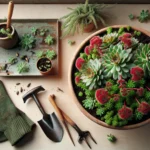Introduction to Sedum Lime Zinger
Imagine a plant that perfectly captures the zesty spirit of a lime, a veritable splash of vibrant green that enlivens your garden palette. Meet the Sedum Lime Zinger, the succulent sensation that’s taking the gardening world by storm! This green gem with a cheeky hint of raspberry is not your average plant; it’s a conversation starter, a scene-stealer, and an unwavering source of beauty for your outdoor space. Let’s dig into the world of this vivacious variety and see why it’s all the rage among those who cherish their chlorophyll-clad companions.

Garden enthusiasts are not just looking for greenery; they crave that special something that pops and sizzles. And pop it does! The ‘Lime Zinger’ illuminates any garden bed or container with its electrifying foliage. Picture those succulent, jade-like leaves edged in a fierce cherry red, reminiscent of a lip-smacking citrus cocktail on a hot summer’s day. It’s more than just a plant; it’s an exclamation mark in your garden dialogue!
The appeal of the Sedum Lime Zinger isn’t merely surface-level; it’s a resilient performer too. Whether it’s basking in full sun or brightening a spot in partial shade, this succulent stands out, come rain or shine. Have a look around our succulent care guide to learn more about nurturing your own collection of these hardy beauties. From rocky outcrops to your serene backyard sanctuary, the ‘Lime Zinger’ is adaptable, undemanding, and endlessly fascinating to observe as it thrives with minimal fuss.
Rarely does a plant exhibit such a delightful combination of charms—easy care, bold visual impact, and sheer adaptability. Whether nestled among a rockery or foregrounding a chorus of taller perennials, Sedum Lime Zinger invariably captivates. Its elegance is without pretension, and its glowing presence ensures your garden is imbued with a touch of the extraordinary. Embrace this effervescent succulent and watch your garden transform into a tableau of living art, teeming with zest and vitality.
Origins and Characteristics
If you’ve ever strolled through a garden and marveled at the vibrant hues of green edged in a bold crimson, you’ve likely encountered the Sedum Lime Zinger. Not your average plant, the Sedum Lime Zinger, scientifically classified as part of the Crassulaceae family, is both a feast for the eyes and a practical choice for gardeners seeking resilience and flair.
Imagine a plant that thrives amid rockeries and borders with its fleshy, succulent leaves that burst into a dramatic fringe as the sunlight kisses its edges—this is the Lace of the Garden, the Sedum Lime Zinger in all its glory. Its origin tale is as alluring as the plant itself, tracing back to skilled breeders who sought to create a sedum that would not only captivate onlookers but would also stand firm against the whims of weather and time.
Cultivating a vibrant tapestry in your garden isn’t just an alluring daydream—it’s a reality made possible by the defining features of this particular sedum. From its apple-green leaves with striking red margins to the way it summons clusters of soft pink flowers in the late summer, it proves to be a hardy hero in any garden setting. This is the kind of plant that demonstrates the power of nature’s artistry.
For those smitten by this intriguing plant and keen on incorporating it into their own space, a wealth of resources is within reach. A visit to the Ultimate Guide to Succulent Care offers a treasure trove of in-depth knowledge, helping garden lovers ensure that their Sedum Lime Zinger becomes a lasting spectacle.
Take action and explore how to care for your Sedum Lime Zinger, so you can transform your garden space into a vibrant display of this botanical wonder. With patience and the right know-how, you’ll see these succulents thrive, carving a mesmerizing journey through colors and textures that’ll leave every onlooker in awe.
And, when you’re ready to expand your succulent horizons, delve into our broad spectrum of articles covering various succulent types. It’s like turning the pages of a botanical storybook, each variety narrating its own tale of resilience and allure.
Bringing Nature’s Artistry to Life
The Sedum Lime Zinger’s allure lies not just in its aesthetic appeal but in what it represents: an invitation to gardeners to play with palettes and textures. Like an artist with a green thumb, one can mold and shape their garden canvas, adding dashes of the Lime Zinger’s verve with each thoughtful placement, creating a living mosaic that evolves with the seasons.
Cultivation Tips for Optimal Growth
If you’re looking to add a pop of color and texture to your garden, the Sedum Lime Zinger is your go-to succulent. This hardy plant not only brings vibrancy but also thrives with a bit of know-how and tender loving care. Let’s dive into how you can go from gardening greenhorn to a Sedum Lime Zinger sage!
Let There Be (Sun)Light
First things first, let’s talk sunlight. These succulents are sun worshipers, requiring at least 6 hours of direct sunlight a day to maintain their stunning lime-green hue. Picture them as little solar panels soaking up the rays to power their vibrant color. If they’re looking a bit pale, or the pinks around their edges have dulled, it’s time to move them to a sunnier spot. Place them where the light is abundant, such as the south or west-facing part of your garden, and watch them glow!
Watering Wisdom
When it comes to watering, the Sedum Lime Zinger is as laid-back as they come. These plants prefer to dry out completely between waterings. Imagine you’re giving them a good, long drink after a dry spell, rather than a steady drizzle. Overwatering is a no-no; these robust beauties can’t stand wet feet! Stick your finger a couple of inches into the soil – if it’s dry, it’s time to water.
Soil Savvy
Beneath every flourishing Sedum Lime Zinger is soil that’s just as robust. The ideal mix is one that drains quickly while providing enough support—think a loamy, sandy substrate akin to their native, rocky habitats. You can even peruse our in-depth guide on succulent soil for customized “recipes” that’ll ensure your succulents have the perfect foundation.
As a real-life example, consider my friend’s garden where these succulents flank the stone pathway, basking in the sun, and impressing passersby with their resilience and barely-there maintenance needs. They radiate health and vitality because she adheres to these uncomplicated care guidelines.
Don’t just take my word for it – see how easy and rewarding it is to propagate and care for these vigorous plants. In the video below, you’ll get practical tips that you can apply directly to your garden endeavors. Happy planting!
Designing with Sedum Lime Zinger
Imagine a splash of electrifying green edged with zesty pink unfolding in your garden—the ‘Sedum Lime Zinger’ brings just that. This succulent plant is a true artist, painting your outdoor space with a palette that revolutionizes garden design. But how do you incorporate such a vivid character into your landscape? Let’s dig into the vibrant world of the Sedum Lime Zinger and unfold the secrets of color pairing and textural contrast to transform your garden into a visually stunning masterpiece.
Firstly, let’s talk color harmony. The Sedum Lime Zinger, with its lime green leaves and pink edges, pairs beautifully with deep purples, rich blues, and even burnt oranges. Imagine a low-growing mosaic where ‘Lime Zinger’ mingles with ‘Purple Emperor’ sedum or ‘Blue Spruce’ sedum—each texture complementing the other, creating a visual dance of colors and forms. But don’t stop at sedums; this versatile plant can stand alongside lavender, whose soft purple spikes provide a striking contrast to the Lime Zinger’s sharp hues.

Texture plays a pivotal role as well. The succulent leaves of the ‘Lime Zinger’ offer a fleshy, full-bodied contrast to the fine, airy nature of ornamental grasses or the delicate fronds of ferns. Embedding it in a bed with such contrasting textures adds a layer of complexity and depth to your garden design. Consider the visual impact of Sedum Lime Zinger against the backdrop of tall, waving grasses—it’s a simple yet bold statement that captivates the onlooker’s gaze.
Don’t forget to exploit the full potential of ‘Lime Zinger’ by using it in containers. Elevated in a sleek, modern pot, this sedum becomes a living sculpture. Pair it with matching or contrasting pots that amplify its coloration—the results can be nothing short of show-stopping. It turns the “usual” potted plant into a thoughtful piece of decor that resonates with the vibrancy of life.
Real-life gardens testify to the brilliance of incorporating the ‘Sedum Lime Zinger’. From urban balconies to rural spread, the ‘Lime Zinger’ takes center stage, proving that great design is not bound by the size of your space. It thrives, creating pockets of joy with its texture and hues, challenging the conventional and encouraging gardeners to dream in color.
Embrace the uniquely spirited ‘Sedum Lime Zinger’ and watch as it enlivens your gardens’ aesthetic, season after season. Whether creating an oasis of calm with complementary cool tones or stirring the senses with contrasting warm shades, the ‘Lime Zinger’ guarantees vibrancy in every nook of your garden space.
Propagation Techniques
Adding a sprinkle of Sedum Lime Zinger vibrancy to your garden is an absolute breeze when you master the art of propagation! Let’s roll up our sleeves and dive into the world of multiplying these succulent charmers. Whether you’re a green-thumbed guru or a budding gardener, our step-by-step guidance is all you need to expand your Sedum Lime Zinger collection.
Cuttings: Snip & Grow
Think of it as giving your plants a trim with benefits! Begin by selecting a healthy, lush stem from your mother plant. With clean, sharp scissors, snip off a piece about 4 inches long, ensuring there are at least a couple of leaves present. Now, here comes the patience part—let the cutting dry for 1-2 days until the cut end callouses over. This simple trick helps prevent rot when it’s time to plant. After the brief wait, nestle your cutting into a mix of well-draining soil and sand. Keep the soil slightly moist and in a few weeks, you’ll be rewarded with signs of new growth. A tip from the pros: Timing is everything. Spring or early summer gives your cuttings a head start, soaking up the season’s optimal growing conditions.
Division: Doubling Down on Sedums
If your Sedum Lime Zinger has matured into a thriving cluster, it’s time to play plant matchmaker. Gently unearth the parent plant and marvel at the bounty of roots. With a keen eye, identify natural sections and carefully tease them apart. Make sure each new section has a good amount of roots attached. Replant these sections into their new homes, be it pots or in your garden bed, and just like setting up friends on a successful date, watch the sparks fly as they settle in and flourish. Remember, the best time to divide is in the coolness of spring or fall—your sedums will thank you with vibrant growth.
Enjoy a visual guide on propagating your Sedum Lime Zinger with this handy video:
With these techniques, propagating Sedum Lime Zinger becomes an enjoyable endeavor, adding layers of texture and color to your garden landscape. Each cutting and divided section is a promise of new growth, embodying the resilient beauty of these hardy succulents. Embrace the rhythm of propagation and watch your garden come alive with the zestful flair of Lime Zinger!
Pest Management and Plant Health
The ‘Sedum Lime Zinger’, with its striking foliage and vibrant presence, can be an absolute showstopper in your garden. But keep in mind, like all plants, this perky perennial can be vulnerable to certain pests and diseases. Let’s dive into what can bug your ‘Lime Zinger’ and how to keep it thriving.
Common Culprits: Pests on the Prowl
Have you ever noticed little critters on your ‘Lime Zinger’? Aphids, mealybugs, and spider mites may cozy up to your sedum. These pests can sap the life right out of the leaves, leaving them discolored and droopy. The aphids are a bit like uninvited guests at a garden party – they just keep coming! They’re attracted to the new growth, with a sweet tooth for the sap. Mealybugs are sneakier, huddling in the nooks and crannies, while spider mites are the clever ones, often escaping a cursory glance while weaving their tiny webs.

Plant Health: Nipping Diseases in the Bud
Diseases can sneak up on your ‘Sedum Lime Zinger’ when you least expect it. Overwatering, for instance, is the equivalent of rolling out the red carpet for fungal diseases such as root rot. It’s like giving your plant soggy shoes, and nobody likes that, especially not your Sedum! Powdery mildew is another uninvited guest that loves to crash the party, leaving a dusty white coat over the foliage as a calling card.
Guarding Your Greenery: The Prevention Game Plan
Monitoring your ‘Lime Zinger’ for pests and diseases is key. Regularly scouting for trouble and catching it early is like having a neighborhood watch for your plants. For aphids and their pals, introducing natural predators like ladybugs or lacewings can be an effective bio-control. They’re like the superheroes of the garden – coming to the rescue and munching on the bad guys. For diseases, ensuring good air circulation and avoiding wetting the leaves can prevent fungal spats. Think of it as giving your ‘Sedum Lime Zinger’ its personal space to breathe and stay healthy.
The Safe Battle: Effective and Eco-friendly Solutions
When pests or diseases do strike, don’t reach for the toxic artillery. Insecticidal soaps and neem oil are the gentle giants here, effective against pests without harm to the environment. It’s like sending pests packing with a firm, but kind, ‘It’s time to leave’. And for the fungi among us, organic fungicides can help keep diseases at bay while keeping your garden a safe space for bees and butterflies. It’s about being the responsible steward of your garden galaxy, ensuring peace and health reign supreme.
The ‘Sedum Lime Zinger’ is not just another plant; it’s a living sculpture in your garden, adding zest and personality. With a little care and some savvy pest-management skills, you’ll keep it looking as vibrant as a lime in the height of summer. Remember, every plant is worth the effort, and your ‘Lime Zinger’ will thank you with its zestful charm!
Seasonal Care for Year-Round Appeal
When the first hints of spring peek through the thawing earth, that’s your cue to start the season’s care routine for the vivacious Sedum Lime Zinger. As the soil warms, ensure that the draining is optimal to prevent water logging, which could spell doom for those sprouting rosettes. A layer of mulch can help regulate soil temperature and retain just the right amount of moisture. Remember, this plant loves the sun, so trim overhead branches that may have grown during winter to maximize sunlight exposure.
As temperatures rise, Sedum Lime Zinger enters its full glory. During the summer, water sparingly, as this succulent thrives in drier conditions, simulating its natural habitat. It’s a good time to introduce a slow-release fertilizer to encourage blooming, and you’ll be rewarded with starry flowers that attract butterflies and create a buzz of life in your garden.

Autumn calls for preparation for the cooler months. This hardy plant needs little caretaking during this time, but it’s wise to remove any fallen leaves that accumulate atop the foliage to prevent rot. The Sedum Lime Zinger’s leaves may take on a brilliant red hue in response to the shorter days, adding a burst of color to your autumnal garden.
When winter’s chill sets in, the Sedum Lime Zinger shows its resilience. Although it’s a tough cookie, limiting water as the plant goes dormant helps prevent ice damage. If you’re in an area with heavy snowfall, consider a cover to protect against breakage from the weight of the snow. Through this all, the Lime Zinger’s persistent nature ensures it will emerge the following spring, ready for another year of vibrant display.
Real-Life Tips for Hardy Perennials
Consider Lena’s garden, with its rivers of Sedum Lime Zinger cascading along the stone path, practically care-free and radiant year-round. She attributes her success to the simple adherence to the plant’s seasonal needs — a bit of pruning here, some strategic watering there. Just like Lena, by tuning into the natural cycle of your Sedum Lime Zinger, you too can nurture a resilient, ever-appealing garden star.
Frequently Asked Questions
Let’s dive into some of the most burning questions garden enthusiasts have about the show-stopping Sedum Lime Zinger. Curious about when its vibrant pink blooms grace your garden? Wondering how to keep it thriving during the winter months? Stick around as we unfold the secrets of this garden gem.
What Makes Sedum Lime Zinger Stand Out in the Garden?
Ever spotted a firework of fuschia amidst a sea of green? That’s Sedum Lime Zinger for you! Its radiant pink flowers burst into bloom in late summer and can carry your garden through to the fall, creating a stunning contrast against its lime-green foliage. Imagine your garden bed transitioning from a tranquil green oasis to a vibrant painter’s palette as these star-shaped beauties make their annual debut.
How Often Do I Need to Water My Sedum Lime Zinger?
Think of your Sedum Lime Zinger like a camel: it stores water and knows how to use it wisely. This succulent enjoys a good drink, but it can handle drought like a champ. The trick is to water it thoroughly and then give it some tough love, letting the soil dry out completely before the next watering. Picture a parched desert getting a quenching rain—it’ll drink up what it needs and then relish the dry spell.
Can It Survive the Harsh Winter?
If Sedum Lime Zinger was a winter sport, it would be ice fishing—patient, resilient, and unfazed by the cold. This succulent endures frost like a seasoned polar bear, hibernating peacefully under snow cover, only to emerge unscathed when the thaw arrives. Just ensure to protect it from winter wetness, which could make it as unhappy as soggy socks on a cold day. A little mulch can go a long way to keep its roots snug and dry.
Does Sedum Lime Zinger Need Special Soil?
Like a gourmet chef preferring a well-seasoned cast iron skillet, Sedum Lime Zinger flourishes in well-drained soil. It’s not fussy about pH levels, but it detests waterlogged feet. A mixture of soil, coarse sand, and compost will make for an ideal haven where this succulent can set its roots firmly yet freely—a perfect recipe for a healthy, happy plant.

And there you have it—a snapshot of the most frequently asked questions about Sedum Lime Zinger, serving as a testament to its resilience and beauty. So go ahead, infuse your garden with a dash of lime and a zinger of pink, and watch how it brings a zestful spark to your outdoor sanctuary.



